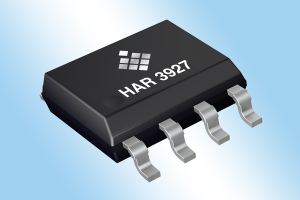TDK Corp. has expanded its Micronas direct-angle Hall-effect sensor family with the HAR 3927 dual-die position sensor for safety critical automotive and industrial applications. The Hall-effect sensor is based on proprietary 3D HAL pixel-cell technology that enables the direct measurement of magnetic fields in three directions (X, Y and Z).

(Source: TDK Corp.)
The dual-die design delivers a fully redundant sensor solution for safety-critical automotive applications. These include linear-movement measurements in dual-clutch transmissions, engine stroke sensors, rotary position measurements in gear selectors and accelerator pedals, and electronic throttle control
The HAL/HAR 39xy devices use licenses from the Fraunhofer Institute for Integrated Circuits (IlS) and address the need for ISO 26262-compliant development (ASIL-B ready). The new sensor offers both a ratiometric analog output as well as a digital SENT interface according to SAE J2716 rev. 4.
The Hall-effect position sensor contains two stacked dies that operate independently. Compared to other solutions with two dies side-by-side, the HAR 3927 operates with significantly smaller magnets, said TDK. The magnetic field amplitude range is 20 mT to 130 mT, and down to 5 mT with reduced accuracy.
The sensor offers two different output formats and a linearization block for an output signal of up to 33 setpoints (17 variable or 33 fixed setpoints). Thanks to the 3D HAL pixel-cell technology, customers can measure magnetic-field components, enabling linear and rotary position measurements up to 360°, as well as on-and-off-axis measurements. The device operates from a 4.5-V to 5.5-V supply voltage.
(Source: TDK Corp.)
Primary characteristics like gain and offset and reference position can be adjusted to the magnetic circuitry by programming the non-volatile memory. The various configuration options can enable one sensor to be used in multiple applications, which reduces costs and effort for re-qualification, said TDK.
Samples of the HAR 3927, housed in a small eight-pin, SOIC-8 package, are available. The start of production is expected in the first quarter of 2022.
about MicronasTDK